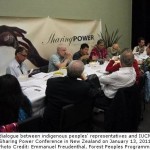
Rio de Janeiro – Over 80 per cent of countries have reformed their water laws in the past twenty years as a response to growing pressures on water resources from expanding populations, urbanization and climate change. In many cases, such water reforms have had positive impacts on development, including improvements to drinking water access, human health and water efficiency in agriculture.
But global progress has been slower where irrigation, rainwater harvesting and investment in freshwater ecosystem services are concerned.
These are among the findings of a United Nations survey of over 130 national governments on efforts to improve the sustainable management of water resources. The survey was specifically produced to inform decision-making at Rio+20.
The survey focuses on progress towards the implementation of internationally-agreed approaches to the management and use of water, known as Integrated Water Resources Management (IWRM).
Backed by UN Member States at the 1992 Rio Earth Summit as part of an overall action plan on sustainable development (Agenda 21), IWRM is a way forward for efficient, equitable and sustainable development and management of the world’s limited water resources.
Amid increasing and conflicting demands on the world’s water supply, IWRM integrates domestic, agricultural, industrial and environmental needs into water planning, rather than considering each demand in isolation.
“An integrated and adaptive approach is essential to ensure that the needs of different user groups, which sometimes compete, are equitably satisfied so that development and management of water resources benefits all,” said the Chair of UN-Water, Michel Jarraud. “Its success depends on a governance and institutional framework that facilitates dialogue and decisions on water resource management which is ecologically, economically and socially sustainable,” he said.
Twenty years after the Earth Summit, world governments are convening once again in Rio, where the critical role of freshwater management in the transition to a low carbon, resource and inclusive green economy is one of several key issues on the table.
The survey, which was coordinated by the UN Environment Programme (UNEP) on behalf of UN-Water (the UN inter-agency co-ordination mechanism for freshwater issues), asked governments for their feedback on infrastructure, financing, governance and other areas relating to water management, to gauge how successful countries have been in moving towards IWRM.
Overall, 90 per cent of countries surveyed reported a range of positive impacts from integrated approaches to water management, following national reforms.
Other key findings include:
- Water-related risks and the competition for water resources are perceived by a majority of countries to have increased over the past 20 years;
- Domestic water supply is ranked by most countries as the highest priority for water resources management;
- The majority of countries reported an increasing trend in financing for water resources development, although obstacles to implementing reforms remain;
- Progress on water efficiency is lagging behind other water management reforms, with less than 50 per cent of national reforms addressing water efficiency.
“The sustainable management and use of water – due to its vital role in food security, energy or supporting valuable ecosystem services – underpins the transition to a low-carbon, resource efficient green economy,” said UN Under-Secretary-General and UNEP Executive Director Achim Steiner.
“As well as highlighting challenges, this new survey also shows important successes regarding integrated water resources management, where a more sustainable approach to water has resulted in tangible benefits for poverty reduction, human health and the environment. At Rio+20, governments have the opportunity to build on these innovations and chart the way forward for sustainable development, where the water needs of a global population set to rise to 9 billion by 2050, can be met in an equitable way,” added Mr. Steiner.
The UN survey shows the major environmental changes that have taken place between 1992, when IWRM was firstly widely backed by governments, and today – and how water resources are managed in the face of such challenges.
The world population, for example, increased from 5.3 billion in 1992 to just over 7 billion today, with impacts being felt most strongly in developing countries. This has been accompanied by increased rural-to-urban migration and high refugee movements due to climatic and socio-political disasters.
Successes and Challenges
The survey shows that the introduction of IWRM on a national level varies greatly across the globe – from early planning stages to concrete implementation of new laws and policies.
When responding to the survey, some governments reported significant development impacts as a result of pursuing IWRM strategies since 1992, such as:
- Estonia: Introducing water charges and pollution taxes contributed to improved water efficiency and a reduction of pollution load into the Baltic Sea.
- Costa Rica: 50 percent of revenues gained from water charges are now re-invested in water resource management.
- Guatemala: Hydropower generation capacity almost doubled between 1982 and 2011.
- Ghana: 40 percent of irrigation schemes for more effective water use and productivity have been rehabilitated.
- Chad: Access to water supply increased from 15 percent in 1990 to 50 per cent in 2011.
- Tunisia: 110 wastewater treatment plants have been built.
Yet many countries – particularly those in developing regions – signaled a need for increased capacity-building, investment and infrastructure development in order to fully implement integrated water resources management.
Country Perception of Key Issues
The water-related issues cited most often as ‘high’ or ‘highest priority’ by governments are infrastructure development and financing (79 per cent of all countries) and financing for water resources management (78 per cent).
Climate change is cited as a high priority for action in a majority of countries (70 per cent overall) and 76 per cent of countries considered that the threat to water resources from climate change has increased since 1992.
But the survey also highlights important differences between developed and developing countries in terms of water-related priorities. Using the Human Development Index, the survey categorized countries in four groups: low HDI, medium HDI, high HDI and very high HDI.
Ensuring adequate water supply for agriculture is a high priority for many low HDI countries, while the preservation of freshwater ecosystems (‘water for environment’) is a priority mainly for very high HDI countries.
Survey Recommendations
The survey includes a number of suggested targets and recommendations, which are designed to inform decision-makers at Rio+20. These are based on an assessment of the findings from the survey and include:
- By 2015, each country should develop specific targets and timeframes for preparing and implementing a programme of action and financing strategy for IWRM.
- By 2015, a global reporting mechanism on national water resources management should be established. This is to ensure a more rigorous reporting system on progress with IWRM, and improve the availability of information.
- More effort is needed to increase levels of financing and to improve the institutional framework for water resources management – especially focusing on low HDI countries.
The UN-Water Assessment was based on two surveys: a questionnaire-based survey among all UN Member States (Level 1 Survey) and an interview-based survey in 30 representative countries (Level 2 Survey). 134 countries responded to the Level 1 Survey, representing 70 per cent of UN Member States and fairly even distribution among geographical regions and HDI groups. A list of all questions and the countries that participated in the survey is provided in an annex to the report.
Source: UNEP.














